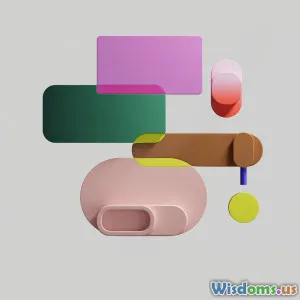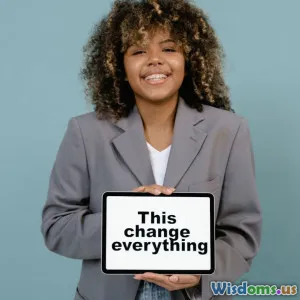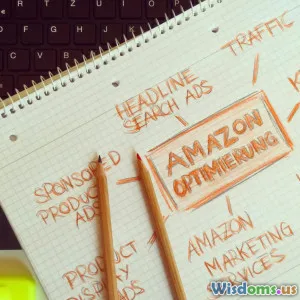
The Future of Graphic Design with AI
8 min read Explore how AI is revolutionizing graphic design, enhancing creativity, and shaping the industry's future. (0 Reviews)
The Future of Graphic Design with AI: Embracing a New Creative Paradigm
Graphic design is at a crossroads. Once reliant solely on human creativity and manual skill, the field is now being reshaped by artificial intelligence (AI). This fascinating fusion promises not only to enhance design processes but also to redefine the boundaries of creativity itself. What does the future look like when AI joins the studio alongside traditional designers? This article examines the cutting edge of AI in graphic design, exploring tools, impacts, challenges, and what this means for designers and businesses alike.
The AI Revolution in Graphic Design: An Overview
AI’s role in graphic design began with automating repetitive tasks but has rapidly evolved into something far more transformative. According to a recent survey by Adobe, over 65% of creative professionals are experimenting with AI-powered tools to enhance their workflows. These tools harness machine learning algorithms to analyze visual styles, suggest color schemes, generate layouts, and even create entire compositions from scratch.
For example, tools like Canva’s Magic Resize and Adobe Photoshop’s AI-powered Neural Filters automate tasks such as resizing graphics and optimizing images with impressive speed and accuracy. Beyond automation, AI is also inspiring designers by providing fresh ideas derived from vast data sets. This capability is already pushing creative boundaries and enabling designers to focus more on concept and storytelling.
How AI Enhances Creative Possibilities
Intelligent Design Assistance
AI-powered platforms now act as collaborative partners. Applications like Adobe Sensei use deep learning to suggest design enhancements tailored to a project’s unique requirements. For instance, if a designer uploads a brand logo, AI can recommend harmonious color palettes or complementary font choices based on current design trends and brand identity principles.
Generative Design and Art
One of the most exciting developments is generative design. AI models like DALL•E and Midjourney create unique graphics and illustrations based on simple prompts. This expands creative potential beyond the traditional skillset and timeframe constraints. Imagine a designer instructing AI to generate hundreds of logo variants or artistic backgrounds instantly—this not only accelerates ideation but also unveils novel styles previously unexplored.
Data-Driven Creativity
AI enhances design by incorporating data analytics directly into the creative process. For example, marketers rely on AI to analyze consumer preferences and generate targeted visuals that boost engagement. Spotify’s use of AI-crafted playlist covers tailored by musical mood exemplifies data-rich, personalized design at scale.
Streamlining Workflow Efficiency
Efficiency gains are among the most compelling reasons businesses embrace AI tools. A 2023 report by McKinsey revealed that companies integrating AI into creative workflows achieved up to 30% faster project delivery and reduced production costs significantly.
Automating Repetitive Tasks
Manual adjustments such as image cropping, background removal, and resizing consume valuable time. AI-driven automation allows designers to delegate these mundane tasks, reclaiming hours for conceptual work. For example, remove.bg’s AI tool can instantly separate subjects from backgrounds across thousands of images—previously a labor-intensive job.
Seamless Collaboration
Many AI-powered platforms facilitate improved team collaboration by automatically organizing assets and suggesting consistency checks aligned with brand guidelines. This minimizes revision cycles and enhances communication among remote teams, a crucial advantage in today's hybrid work environment.
Accessibility and Democratization
AI tools lower the barrier to entry for aspiring designers lacking formal training. User-friendly interfaces combined with AI support empower small businesses and freelancers to create professional-grade graphics without extensive expertise or budget.
Challenges and Ethical Considerations
While AI offers remarkable potential, it also raises critical challenges.
Creativity versus Automation
A common concern among designers is whether AI diminishes the personal, artisanal touch essential to compelling design. Some argue that overreliance on AI-generated work can lead to homogenized visuals lacking unique human emotion or storytelling.
Intellectual Property and Attribution
With AI generating original content by learning from massive data sets, questions about copyright ownership and ethical sourcing have become hot topics. The legal frameworks for AI-created artwork remain underdeveloped, posing risks for both creators and users.
Bias in AI Outputs
AI systems inherit biases present in their training data, which can inadvertently perpetuate stereotypes and limit diversity in design. Ensuring fair and inclusive outputs requires ongoing dataset curation and algorithmic transparency.
Looking Ahead: The Hybrid Designer Model
The future will likely see a hybrid model where expertise and AI complement each other. Rather than replacing designers, AI is envisioned as an amplifying tool that extends human creativity and amplifies productivity.
Upskilling Designers for the AI Era
Design education programs increasingly integrate AI literacy, teaching future creatives how to wield AI tools responsibly. This interplay between human intuition and machine precision is set to become the new norm.
Emerging Technologies: Augmented Reality and AI
Combining AI with augmented reality (AR) allows for immersive, interactive design experiences. Businesses like IKEA are pioneering AI-driven AR apps that help users visualize furniture in real-time through their smartphones, transforming user engagement.
Ethical AI Design Frameworks
Proactive approaches to developing transparent, ethical AI design standards will play a vital role in ensuring technology benefits the creative community and society as a whole.
Conclusion: A Transformative Partnership
The integration of AI into graphic design heralds a thrilling period of evolution. From accelerating workflows and enhancing creative horizons to democratizing design access, AI is already reshaping the industry landscape. However, embracing this transformation requires balancing automation with authentic human creativity and addressing ethical complexities.
As AI continues to mature, designers who engage with these tools proactively will find themselves empowered with unprecedented capabilities. The future of graphic design is not AI versus human—it is AI with human, working collaboratively to imagine, create, and innovate like never before.
Author’s note: As AI technology evolves, staying informed and adaptive will be key for all creative professionals aiming to thrive in this exciting new era.
Rate the Post
User Reviews
Popular Posts





















